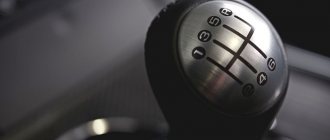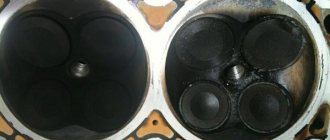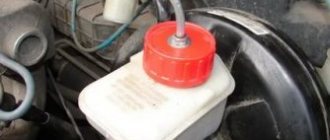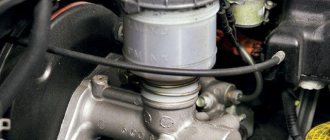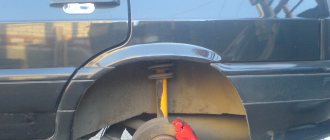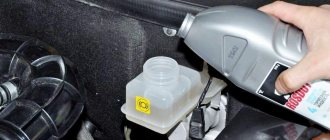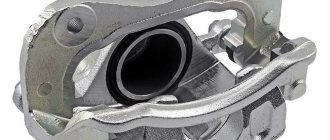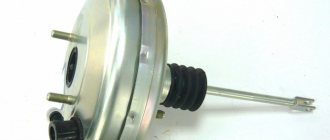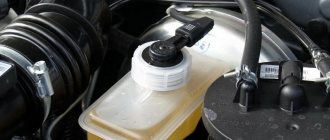Like any car, the IS also has problems that often become a puzzle for the average car mechanic.
This time the problem was the brake system malfunction indicator (a light indicating that the hand brake has been lifted). It lights up and doesn't go out. We started looking at the handbrake, thinking that the button was stuck. No, when you lift it, a beep appears, which means the chip and the button are ok. Next we checked the brake fluid level - NORMAL. When the methods of “scientific poking” ended, they took us to the master. Without hesitation, the master plugged in the computer and fiddled around, but couldn’t find anything. His conclusion was as follows: leave the car so he could ring the wiring, maybe one of the sensors is acting up or the contact is exposed and shorted to something.
This, of course, made me think and go Google, which gave me several reasonable, and most importantly simple, directions for action. By studying circuit diagrams, including electrical circuits, books on car maintenance and other things, as well as by the method of elimination, 4 main possible causes were identified.
So, a simplified version
Problem:
The light on the dashboard is on (and does not go out), indicating a malfunction of the brake system.
Possible reasons:
(if the indicator does not light up when you start the car, but lights up when you press the brake pedal, then most likely you can skip the 1st point) 1. Brake fluid level sensor 2. Brake pad wear 3. Central brake light lamp 4. Button or chip handbrake
Diagnostics:
1. The electrical circuit diagram is designed in such a way (including the structure of the sensor - it gives a signal only when the liquid level is low) that if you disconnect the reservoir sensor chip with the brake, then the comp. will think that the level is normal. Therefore, disconnect the chip, and if the indicator goes out, then the problem is there. 2. If the wear of the pads is very large, the fluid level may drop when pressed and the indicator will light up. 3. If disconnecting the chip (see step 1) did not have any effect, then you probably have this exact problem. Press the brake and see if the central brake light is on. If it doesn't light up, that means it's the problem. 4. With the car running, raise the handbrake, if a sound signal appears, then everything is in order, if there is no sound, it makes sense to look
Why does the indicator ((!)) appear?
The brake system consists of a mechanical part (discs, pads, brake fluid, lines, etc., manual or electric parking brake) and an electronic part - a set of sensors and wiring.
Only on certain car models, signals from different sensors are indicated by the lighting of individual lamps, and then the letter ((P)) on the dashboard indicates that the handbrake is engaged, and the icon ((!)) indicates a malfunction of the main brake system.
Often, cars have only one warning lamp, which receives signals from the brake fluid level sensor, pad wear, brake light and handbrake.
How is a hydraulic hand brake designed and how does it work?
If you ask yourself about the operation of a hydraulic handbrake, you can find some similarities with a mechanical handbrake. There is also a lever available here, there is a ratchet (geared) wheel, but instead of cables there are some liquid pistons; they are connected to the hydraulic lines of the main brake system. The main positive feature of this modification is a simpler repair procedure. The driver also does not need to adjust anything. All mechanical functions are performed by hydraulics.
The disadvantage of this system is that if there is a violation in the tightness of the brake circuit, then the car will have no chance to brake in an emergency. Thus, the leakage of fluid will leave the car owner not only without the main brakes, but also the handbrake.
How to define the problem more accurately
If the indicator lights up during hard braking, this is an argument in favor of the version with worn pads. The solution is to replace the pads.
If the light periodically goes out, this may be due to the fact that the liquid splashes in the tank during driver maneuvers, and at some moments its level is below the diagnostic float. The solution is to check the tank and add DOT to the level.
ABS lamp lights up along with the indicator ((!)) , this indicates that the ABS sensor has failed.
On Renault models with an electronic handbrake, the “Brake” lamp may come on due to a faulty parking brake sensor.
How does a mechanical handbrake work? Let's consider its principle of operation
Looking through the list of internal parts of this mechanism, we notice only one - a lever. There are cases when it can be replaced by a small pedal, located somewhat away from the main pedals responsible for driving the car. Using a number of parts, as well as tensioners and fuses, the lever is connected to mechanisms that block the rear wheels.
A ratcheting wheel is installed in the lever itself; it fixes the operating mode and is a safety device. The force transmitted by the driver is distributed over two or three cables, which are connected to the pads through special parts. A scheme with three parts is often used, these are two side ones that lead to two rear wheels, but the central cable plays an important role in the distribution of the applied forces. The drives are connected to each other through the main part - the block.
Specially designed levers are necessary to control the operation of the pads. There is their connection with the right and left cables in a situation when the lever is turned on and the fuse is triggered, they will precisely press the handbrake pads to the walls of the drums or rotors. All the main parts of the parking mechanism are aligned using tips that have a length that can be adjusted. If the cables are stretched, this will allow the tension to be adjusted to them without replacing all the internal components of this system. The manual parking mechanism is not the only representative; there is also a hydraulic type and an electronic one, which also have fuses.
What to do if the lamp ((!)) lights up while moving
Be prepared for the worst - brake failure. Turn on the emergency lights and carefully check whether the brakes respond to pedal pressure.
- If the pedal fails, try to “bleed” the system with a few strong presses.
Look for a place to stop, slow down using engine braking or applying the parking brake.
After stopping, check the brake fluid level. Further options are possible.
If the DOT level is OK, check the condition of the handbrake and the condition of the brake lights:
- Find the handbrake sensor (in a situation with an electric parking brake - right under the button), put the car on the handbrake and press the sensor rod. If the brake system indicator goes out when pressed, the reason is a faulty sensor.
- ask your assistant to depress the pedal (or press it down with improvised means) and inspect the lights yourself.
What you need to know about electronic handbrake?
In an electronic parking brake, all important actions are performed by the car’s computer unit, as well as the handbrake sensor. When the engine is turned off, the system polls the tilt sensor, which measures the horizontal position of the vehicle. If horizontal violations are detected, the computer will activate the electronic handbrake drive, which, in turn, using a clamping screw, will activate the handbrake pads.
The parking lock can be turned off automatically when the car starts and the driver presses the gas pedal; for this, a sensor is used, the operation of which is controlled by a fuse. To artificially disable this type of handbrake, you need to press the pedal and the handbrake sensor will understand that it is necessary to disconnect the pads.
Checking the brake fluid level sensor
Release the parking brake and check the brake fluid level in the reservoir.
If the fluid level in the tank is below the “MIN” mark, and the corresponding icon in the instrument cluster does not light up, press the latch and disconnect the block with wires from the sensor. We close the contacts of the wiring harness block with a piece of wire.
- If the lamp does not light up, then there is a break in the car's wiring.
- If the lamp lights up, the sensor is faulty.
If the fluid level is normal (between “MIN” and “MAX”), and the warning lamp continues to light after starting the engine, press the latch and disconnect the block with wires from the sensor.
- If the lamp goes out, the sensor is faulty.
- If the light remains on, there is a short circuit in the vehicle's wiring or the instrument panel is faulty.
The sensor is replaced together with the brake master cylinder reservoir. A malfunction of the brake system is also indicated by burning ABS and ESC lamps.
What will it be like in practice in 2022?
Today, on the road, an ordinary traffic police inspector does not have the right to check various types of car systems... And he will not be able to do this - at least if access to the ABS hoses is not visible under the hood.
Involving technical specialists just to check the operation of the braking system, even on trucks, is a very rare and almost unrealistic phenomenon in practice. However, traffic police officers often resort to illegal methods when stopping trucks. This includes asking you to press the brake and hold it, checking the pressure drop in the brake system.
But the key word here is “ask.” You can refuse the inspector's request. And for you to be punished for failure to comply with a police officer’s request, it must be legal. In this case, such verification is not supported by any regulatory act.
However, checking the performance of ABS becomes a completely bleak prospect in the event of an accident - especially if there are victims. As part of a criminal case involving hit-and-run pedestrians, for example, an examination is often carried out to check the serviceability of the brakes. The anti-lock braking system is also tested.
In an administrative case, a traffic police officer is simply more likely to order an examination if this is necessary for a comprehensive consideration of the case of an accident and the presence of a violation by one of the drivers.
Thus, the probability of detecting a non-functional ABS system on the road when communicating with traffic police is quite low, although not zero. But in the event of a traffic accident, the prospect of ordering an examination of the brake system becomes more likely - especially if there are injured pedestrians.
Why is a fine for cars illegal?
What do we care about the legality of a fine according to the letter of the law? So, we have previously found out, for example, that demands for tinting are illegal. However, they are quite common, and even the courts enforce such punishments.
The practical value of this matter is important to us. And it lies in each specific case. Simply put, your task is to convince the official reviewing the case or the judge during the appeal that the decision with a fine for a non-functioning ABS was made illegally. That is, in each specific case it will be possible or not to be done.
And you can convince of illegality based on various arguments:
- citing laws, government regulations or orders,
- citing judicial acts - especially, decisions, decisions or rulings of the Supreme Court will have weight.
And we will provide you with all the legal acts that are in one way or another related to our question of what the fine is for ABS.
We will not consider the reasonableness of penalties for trucks carrying dangerous goods. We found out above that the punishment under 12.21.2 in this case is quite legal. However, liability for the ABS light or a malfunction of the system itself under Part 2 of Article 12.5 is a big question.
What do the traffic rules say?
So, the main reason why a fine for a faulty anti-lock braking system is not based on the law and the only legal argument that will help you avoid punishment is traffic rules.
The fact is that the entire article 12.5 of the Code of Administrative Offenses of the Russian Federation provides for liability for malfunctions and conditions under which the operation of vehicles is prohibited. This means that somewhere it should be prohibited to drive a car:
- if her ABS system does not work,
- if the ABS light is on, even if the system itself is in good condition.
So, the title of Article 12.5 itself repeats and refers in Part 1 to the corresponding List of Faults - an appendix to the Traffic Regulations. Let's go to this regulatory act. And immediately in section 1 we read a list of faults in which the car cannot be driven... And we do not find a single mention of ABS here. It follows from this that Article 12.5 is not applicable in this case, and the fine for faulty ABS was issued illegally, since there is not a single condition for prohibiting operation when the indicator lamp is on.
There is a ban in the Technical Regulations
In particular, paragraph 1.15 and its subparagraphs of Appendix No. 8 of the regulations establish the following requirements:
- all fastenings must be reliable (look so), the ABS must be complete, and most importantly, the system must be in working condition,
- The ABS light should turn on after the car's ignition is turned on and go out no more than 10 seconds after starting to move,
- the car (car or truck - no difference) must move straight when braking from a speed of more than 40 km/h,
- On air brakes (on trucks), the air release mufflers must work properly.
As you can see, there are requirements both for the anti-lock braking system to work as such and for the ABS lamp - it should not be constantly on.
But the main thing is that the Code of Administrative Offenses does not provide for liability for these regulations. You may face a fine of 500 rubles for violations of the List of Faults, but not the regulations.
Changes in the law
Meanwhile, a new edition of the above List is under consideration, a fine for violations of which could be legal.
Thus, paragraphs 11 and 12 of the updated regulatory act literally contain the following regulations under which it is prohibited to drive a car:
Elements of the anti-lock braking system (hereinafter referred to as ABS) are not securely fastened and disconnected, there is visible damage. The ABS provided by the manufacturer in the vehicle's operational documentation is faulty. Note. The serviceability of the ABS is determined using a light indicator for monitoring the ABS operating condition.
Thus, if this change is introduced, then the fine will be quite real and legal. However, it is not yet known when this will happen.
Something else useful for you:
- How correctly are drivers required to give way to pedestrians at a crossing under the new rules?
- Rooms are covered in snow - fine or deprivation? The inspector threatens to revoke your rights
- Is there a penalty for driving with a broken, broken or cracked windshield and what is it?
What is this device for?
The purpose of this simple device, in principle, is not particularly complicated and understandable for every car enthusiast - to signal that the brake fluid has reached a critical point. This, accordingly, means that it needs to be changed as soon as possible or simply replenished with this fluid. In fact, the VAZ 21103 brake fluid level warning lamp is a device, although extremely simple, but very useful.
This can be said because it can indicate not only that the brake fluid has run out, but also the following phenomena:
- the pads need to be replaced;
- the metal washer under the rubber cap on the rod sits unevenly;
- The brake fluid lamp itself on the VAZ 2110 has failed.
All these problems, in principle, can be solved using fairly simple methods that are familiar to almost all modern drivers.

